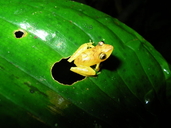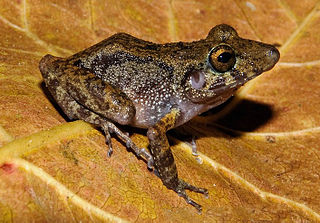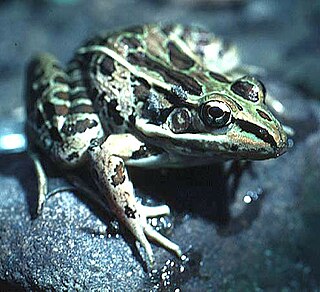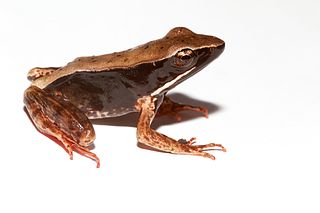Edward Harrison Taylor was an American herpetologist from Missouri.

The Wildlife of Costa Rica comprises all naturally occurring animals, fungi and plants that reside in this Central American country. Costa Rica supports an enormous variety of wildlife, due in large part to its geographic position between the North and South American continents, its neotropical climate, and its wide variety of habitats. Costa Rica is home to more than 500,000 species, which represents nearly 5% of the total species estimated worldwide, making Costa Rica one of the 20 countries with the highest biodiversity in the world. Of these 500,000 species, a little more than 300,000 are insects.

Cochranella euknemos, sometimes known as the San Jose Cochran frog, is a species of frog in the family Centrolenidae. It is found in central Costa Rica and south/eastward to Panama and to the western flank of the Cordillera Occidental in Colombia. Some Colombian records might apply to Cochranella mache.
Silverstoneia nubicola is a species of frog in the family Dendrobatidae. It is found in western Colombia, Panama, and southwestern Costa Rica.

Agalychnis saltator is a species of frog in the family Phyllomedusidae. It is found in the Caribbean lowlands from north-eastern Honduras through Nicaragua to east-central Costa Rica at elevations of 15–1,300 m (49–4,265 ft) asl. Its common names are parachuting red-eyed leaf frog and misfit leaf frog.

The Panama cross-banded tree frog is a species of frog in the family Hylidae found in the humid Pacific lowlands of southwestern Costa Rica to eastern Panama and in the Caribbean lowlands of Panama and northern Colombia.
Craugastor andi is a species of rain frog in the family Craugastoridae which has not been seen since 1990. It is found in the Caribbean drainage of Costa Rica in the mountains and hills of the Cordillera Central and the far northeastern Cordillera de Talamanca, and in extreme northwestern Panama. Frank and Ramus (1995) give it the vernacular name Atlantic robber frog. It is known locally in Spanish by the generic names, used for many species, of rana de hojarasca, ranita or sapito.

Strabomantis bufoniformis is a species of frog in the family Craugastoridae. It is found in western Colombia, Panama, and southeastern Costa Rica. It is sometimes known as the rusty robber frog.

Craugastor mimus is a species of frog in the family Craugastoridae. It is found in lowland and premontane forests on the Atlantic versant from eastern Honduras through eastern Nicaragua to central Costa Rica. Its natural habitat is lowland and premontane moist and wet forests. It is threatened by habitat loss.
Craugastor ranoides is a species of frog in the family Craugastoridae. It is found in the southern Atlantic lowland of Nicaragua and northwestern Costa Rica, and through Costa Rica to extreme western Panama. Its natural habitats are, principally, lowland and premontane wet forests in association with small streams, but also dry forests with perennial streams. It is threatened by habitat loss and chytridiomycosis. The species has disappeared from much of its former range in Costa Rica, also in pristine habitats, possibly because of chytridiomycosis.
Craugastor rayo, also known as the Sabana robber frog, is a species of frog in the family Craugastoridae. It is endemic to the Cordillera de Talamanca, Costa Rica.

Craugastor taurus is a species of frog in the family Craugastoridae. It is found in the Golfo Dulce region of southern Costa Rica and adjacent western Panama. It is sometimes known as the Golfito robber frog.
Pristimantis altae is a species of rain frog in the family Craugastoridae with a bright coral-coloured groin. It is found in Costa Rica and Panama. It is locally known as sapito de hojarasca. In 2008 the IUCN began calling it the mountain robber frog following Frank and Ramus (1995).

Pristimantis caryophyllaceus is a species of frog in the family Craugastoridae. It is found in Costa Rica and Panama; records from Colombia prior to 2010 refer to Pristimantis educatoris. However, taxonomy of Pristimantis caryophyllaceus and P. educatoris remain unsettled, and many sources continue to report Pristimantis caryophyllaceus from Colombia.

Pristimantis gaigei is a species of frog in the family Craugastoridae. It is found in the Atlantic drainage lowlands from extreme southeastern Costa Rica to eastern Panama and to central Colombia; it is widely distributed in Colombia west of the Cordillera Oriental. Its natural habitat is primary humid lowland forest, but it also occurs in secondary forest. It is a nocturnal species found under surface debris and in leaf-litter.

Forrer's grass frog or Forrer's leopard frog, Lithobates forreri, is a species of frog in the family Ranidae found in Mexico and Central America through Guatemala, El Salvador, Honduras, and Nicaragua to Costa Rica. It is a widespread and common frog found in lowland and seasonal tropical forests. It can also adapt to man-made habitats such as flooded agricultural lands and other water content systems. Reproduction requires permanent pools and lagoons.
The Northwest Mexico leopard frog is a species of frog in the family Ranidae endemic to Mexico. This predominantly aquatic frog inhabits temporary or permanent pools in shrublands and mesquite forests. It might be threatened by droughts.
The Mexican cascades frog or white-striped frog, Lithobates pustulosus, is a species of frog in the family Ranidae endemic to Mexico, where it is known as rana de cascada.
Lithobates vibicarius, commonly known as either green-eyed frog or Rancho Redondo frog, is a species of frog in the family Ranidae from highland rainforests in Costa Rica and western Panama.

Warszewitsch's frog is a species of frog in the family Ranidae found in Honduras, Nicaragua, Costa Rica, and Panama.












